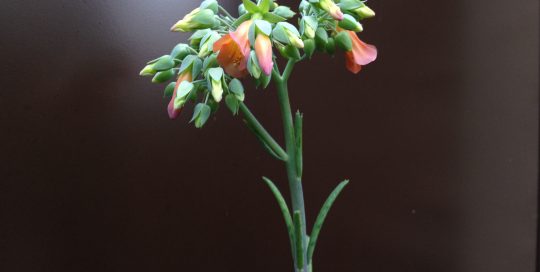Easy Annuals for Window Boxes
Views: 93053

I remember the first group of window boxes I cared for at a landscape client’s home. I planted them with dark purple Coleus, Dusty Miller, Silver Licorice Vine, and purple Petunias. And boy were they ugly!
I took over care of them in early summer and was not yet aware of the fact that many annuals respond well to pinching or light pruning. So I let the Coleus go and of course it got really big and bloomed, blocking out much of the client’s windows. Also, I only planted the Silver Licorice Vine on one side of each of the boxes. They quickly looked lopsided as the vigorous vining plant took over that side.
Thankfully, I have learned a lot since then, and my client’s window boxes are much better off now that I know to regularly trim annuals to keep them in shape.
Creating Successful Window Boxes
Window boxes require special consideration because of the limitations created by the size of the box itself, as well as those imposed by planting in front of a window that you most likely want to continue to see out of.
Root space is at a premium in window boxes, so it’s crucial to keep them moist and fertilized. Mix in a slow release fertilizer before planting or use a water-soluble fertilizer once a week when watering. Also, the amount of light a window box receives can really vary depending on which side of the house it’s on. The north side of a house will most likely be full shade while the south side would get full sun. Using annuals that tolerate varying light conditions will help ensure the success.
For a beautiful and foolproof window box, simply fill it with one type of annual that gets at least 6 inches tall. For a slightly more complex (and yet still foolproof) window box, pair that same annual with another kind that drapes.
Best Plants
It’s hard to go wrong when you use such a limited palette. You will probably need at least five plants to fill an average window box (assuming that you start with a 3- to 4-inch annual). If you want more variety, it’s best to think in tiers with window boxes, including tall, short, and draping elements. I prefer not to use more than three or four varieties in one box, so I use multiples of the same plants and cram them in for an instantly full look.
A good way to estimate the number of plants needed for most mixed window boxes is to plan on using 3 tall plants across the back of the box, 2 short plants offset from these in the middle, and 3 draping plants across the front edge of the box. Extra-large window boxes will require adding one or more plants to each of these “rows.” Remember to keep the style of your home in mind and stick with a theme like hot or cool colors. If you have multiple window boxes, it’s best to repeat the same plant palette in all of them to create a unified look on your house.
Here are some of my favorite low maintenance annual flowers for window boxes:
Coleus:
You can’t go wrong with Coleus for sun or shade, just keep in mind that Coleus in sun will require more frequent watering. Great when used all alone or as a tall element in mixed window boxes, Coleus comes in an amazing array of leaf shapes and colors. Keep it trimmed to a nice size and pinch off blooms. I also love the vining Coleus varieties, which are a great addition to any mixed container as a colorful low draping element.
Dragon Wing™ Begonias: These graceful arching annuals come in red and pink and perform well in sun and shade. They fill out window boxes nicely all alone or when used as the tall element in a mixed container. No deadheading means these annuals are truly low maintenance and their shallow roots are well-suited to window boxes.
Euphorbia: This classic airy white blooming plant is a good choice for adding a low and slightly draping element. This is another self-cleaning annual, meaning no deadheading is required. Remember that white is best paired with only one other color. Euphorbia does best in full to part sun, but will tolerate shade as well.
Geraniums: I love both Zonal and Ivy Leaf Geraniums in window boxes. Their shallow root systems are perfect for the tight conditions. Geraniums prefer to stay on the dry side, so it’s important not to over water them. Deadheading is easy, just gently snap off old flower stems. Ugly leaves are equally as easy to remove. Geraniums come in a wide variety of bloom colors and are perfect when used as a medium to tall element (Zonal) or as a low draping element (Ivy Leaf). They prefer part sun, but can take the whole spectrum from full sun to full shade.
Dichondra:
Grown for its silver or green foliage, Dichondra is perfect for cascading over the edge of a window box. It does best in full to part sun and make sure to keep it trimmed so that it won’t touch the ground and spread. Don’t use silver Dichondra if your window box is mounted on grey-toned siding or stone, as it will pretty much disappear into the background when used against a color so similar to its own.
Golden Creeping Jenny (Lysimachia): Because of its eye-catching bright green color, this trailing plant will really draw attention to window boxes. Perfect when paired with a variegated Coleus that has the same chartreuse flecked in its leaves. Will grow in full sun to full shade. This is another vining plant to keep trimmed above the ground or it will root where it touches the ground.
Impatiens: The perfect size for window boxes in the shade, Impatiens require no deadheading and their small root systems won’t compete with other annuals for space. They come in a dazzling array of colors and will fill a window box nicely on their own or when combined with other annuals. For a great mixed window box in the shade, combine Impatiens with taller Coleus and draping Creeping Jenny.
Verbena: This perky draping plant is well-suited for window boxes in full to part sun. Perfect for the front and middle of a window box, Verbena comes in many colors and is generally not fussy as long as it gets regular water.
Meet Abbi Hayes
Abbi's Recent Posts

Kalanchoe delagoensis: Mother of Millions







